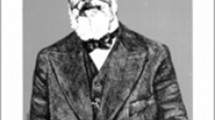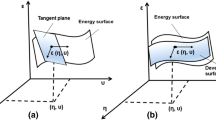Abstract
Having refuted the phlogiston theory, Lavoisier uses this second portion of his essay to expound his new theory of combustion, based on the oxygen principle. He gives a mechanistic account of thermodynamic phenomena in terms of a subtle fluid (not yet named “caloric”) and its ability to penetrate porous bodies. He uses this hypothetical fluid to explain volume changes, heat capacity and latent heat. Beyond the three types of combustion that he distinguishes and defines, Lavoisier also explains other chemical sources of heat, such as the heat of solution.
Similar content being viewed by others
Notes
Archaic French units have been translated into modern scientific units throughout. Original reads ‘a temperature of 80° [Réaumur], under a pressure of 28 [French royal] inches [of mercury]’; this pressure is equivalent to 760 mmHg.
The origin of this concept is traditionally ascribed to Joseph Black (1728–1799), who corresponded with Lavoisier and taught many British chemists but published little in his lifetime. The term “capacity” is certainly used in his notes—Lectures on the Elements of Chemistry. Creech, Edinburgh (1803), vol. I, p. 78 and passim.
Original reads “to melt a [French] pound of ice, it requires a [French] pound of water at 60° of a mercury thermometer divided into eighty parts” (i.e. the Réaumur scale).
Original reads “at 49° 1/3 [Réaumur]”, which is exactly equivalent.
Original reads “at 31° 3/4 [Réaumur]”, which is exactly equal to 39 11/16 °C.
Adair Crawford (1748–1795) never used the term “specific heat” in his Experiments and Observations on Animal Heat, and the Inflammation of Combustible Bodies. Murray, London (1779). Instead, he referred to the “capacity” for receiving or containing heat (following Black and William Irvine). Lavoisier’s knowledge of Crawford’s ideas came through a précis written in French by John Hyacinth de Magellan (1722–1790), which does use the term chaleur spécifique—Essai sur la nouvelle théorie du feu élémentaire, and de la chaleur des corps. Observations sur la physique, sur l'histoire naturelle et sur les arts 17, 375–386, 411–422 (1781). For a detailed discussion of Lavoisier’s debt to Crawford and Magellan, see Morris (1972, 9ff) and Guerlac (1976, 230ff).
The British chemists used the term “sensible heat” in an equivalent way, similar to the concept of temperature, when derived from the Zeroth Law of Thermodynamics (Crawford 1779, 4). Lavoisier's uncertainty here probably stems from the fact that his apparent source of knowledge of Crawford's work openly disagrees with the British school's use of the term “latent heat”. Magellan insists that the heat of phase changes is still "sensible" because its effects can be perceived (1781, 381), albeit not as a change in temperature. Lavoisier and Laplace also eschew the term “latent” (Morris 1972, 13n50).
Lavoisier, Laplace: Memoir on Heat. Watson, New York ([1780] 1982), 9. Original directs the reader to Mém. Acad. R. Sci. Paris année 1780, 355–408 (1784), 364.
[Lavoisier:] It is the detonation of nitre being discussed here. With respect to the detonation of vital and inflammable air in closed vessels, the noise and the explosion that accompany it are an effect of the immediate dilation of the water that forms and that occupies a greater space than that of the two airs while it exists as vapour; but it soon condenses and then the volume of the two airs disappears.
Mémoire sur l'existence de l'air dans l'acide nitreux et sur les moyens de décomposer et de recomposer cet acide. In: Dumas (ed.) Œuvres de Lavoisier, vol. II, pp. 129–138. Imprimerie Impériale, Paris ([1776] 1862).
Georg Ernst Stahl (1659–1734) German chemist and physician, originator of the phlogiston theory of combustion. His French “disciples” included Pierre-Joseph Macquer (1718–1784) and Antoine Baumé (1728–1804); for a discussion of the extent to which they shared a single doctrine, see Part I of the present essay.
Gaspard Monge (1746–1818) French mathematician and physicist.
Alexandre-Théophile Vandermonde (1735–1796) French mathematician and chemist who frequently collaborated with Monge. Either the particular work to which Lavoisier refers is no longer extant (Morris 1978, 19n78) or he means a paper by Monge read to the Academy by Vandermonde 6th August 1783, after the conclusion of the present paper on 13th July—Mémoire sur le résultat de l'inflammation du gas inflammable & de l'air déphlogistiqué. Mém. Acad. R. Sci. Paris année 1783, 78–88 (1786). This is one of Monge's few published works on chemistry. In it he attempts an interpretation of gasses as substances dissolved in the matter of heat but does not commit himself to a specific model.
Mémoire sur la combustion en général. In: Dumas (ed.) Œuvres de Lavoisier, vol. II, pp. 225–233. Imprimerie Impériale, Paris ([1777] 1862).
Nothing published by Lavoisier after the reading of this essay seems to fit that description. He did discuss detonation in a section of his famous textbook (On Deflagration. In: Kerr (ed.) Elements of Chemistry in a New Systematic Order, pp. 452–459. Creech, Edinburgh ([1789] 1790)) and produced a short article titled “Detonation” in 1793 (which was destined for F.R.J. de Pommereul’s never-published Dictionary of Artillery, part of C.-J. Panckoucke’s Encyclopédie Méthodique)—Sur la Détonation. In: Grimaux (ed.) Œuvres de Lavoisier, vol. V, pp. 311–316. Imprimerie Nationale, Paris ([1793] 1892). For Lavoisier’s views of the detonation of nitre before his rejection of phlogiston theory, see Holmes (1987, 35f).
References
Black, J.: Lectures on the Elements of Chemistry. Creech, Edinburgh (1803)
Crawford, A.: Experiments and Observations on Animal Heat, and the Inflammation of Combustible Bodies. Murray, London (1779)
Guerlac, H.: Chemistry as a branch of physics: Laplace’s collaboration with Lavoisier. Hist. Stud. Phys. Sci. 7, 193–276 (1976)
Holmes, F.L.: Lavoisier and the Chemistry of Life: An Exploration of Scientific Creativity. University of Wisconsin Press, Madison (1987)
Lavoisier, A.L.: Mémoire sur l’existence de l’air dans l’acide nitreux et sur les moyens de décomposer et de recomposer cet acide. In: Dumas, J.-B. (ed.) Œuvres de Lavoisier, vol. II—Mémoires de Chimie et de Physique, pp. 129–138. Imprimerie Impériale, Paris ([1776] 1862). Originally published in: Mém. Acad. R. Sci. Paris année 1776, 671–680 (1779)
Lavoisier, A.L.: Mémoire sur la combustion en général. In: Dumas, J.-B. (ed.) Œuvres de Lavoisier, vol. II—Mémoires de Chimie et de Physique, pp. 225–233. Imprimerie Impériale, Paris ([1777] 1862). Originally published in: Mém. Acad. R. Sci. Paris année 1777, 592–600 (1780)
Lavoisier, A.L.: On Deflagration. In: Kerr, R. (ed.) Elements of Chemistry in a New Systematic Order. pp. 452–459. Creech, Edinburgh ([1789] 1790). Originally published in: Traité élémentaire de chimie, pp. 524–533. Cuchet, Paris (1789)
Lavoisier, A.L.: Sur la détonation. In: Grimaux, É. (ed.) Œuvres de Lavoisier, vol. V, pp. 311–316. Imprimerie Nationale, Paris ([1793] 1892)
Lavoisier, A.L., Laplace, P.-S. de: Memoir on Heat. Watson, New York ([1783] 1982). Originally published as: Mémoire sur la chaleur. Imprimerie Royale, Paris (1783)
Magellan, J.H. de: Essai sur la nouvelle théorie du feu élémentaire, et de la chaleur des corps. Observations sur la physique, sur l’histoire naturelle et sur les arts 17, 375–386, 411–422 (1781)
Monge, G.: Mémoire sur le résultat de l’inflammation du gas inflammable and de l’air déphlogistiqué. Mém. Acad. R. Sci. Paris année 1783, 78–88 (1786)
Morris, R.J.: Lavoisier and the caloric theory. Br. J. Hist. Sci. 6, 1–38 (1972)
Acknowledgments
The translator would like to thank Florence Greffe, chief archivist at the Académie des Sciences of Paris, and her staff for allowing him to consult handwritten drafts of Lavoisier’s paper. He is also grateful to the Department of History and Philosophy of Science at Indiana University for the award of a Richard S. Westfall Fellowship, which enabled him to take that trip. Parts of this work were completed while on short-term fellowships from the Chemical Heritage Foundation and the Philadelphia Area Center for the History of Science (now the Consortium for History of Science, Technology and Medicine). He thanks both these organisations for their financial support, for access to many pertinent documents and for sharing the expertise of their library staff (particularly Jim Voelkel of the CHF). Cindy Elbaz and Bill Newman provided invaluable advice on various aspects of this translation but the translator takes full responsibility for any mistakes that may remain.
Author information
Authors and Affiliations
Corresponding author
Additional information
This is the second part of a paper read by Antoine Lavoisier at the Royal Academy of Sciences of Paris over two nights, starting 28th June and concluding 13th July 1783. Pagination given here in square brackets is from the version published as “Réflexions sur le phlogistique, pour servir de suite à la théorie de la combustion et de la calcination, publiée en 1777” in Dumas, J.-B. (ed.) Œuvres de Lavoisier, vol. II, pp. 623–655. Imprimerie Impériale, Paris (1862). All footnotes are the translator’s comments, except note 9 (D 651), which is Lavoisier’s. The subtitle “On the Nature of Heat”, given to this second portion, is not part of Lavoisier’s original work. The first half appeared in Foundations of Chemistry, vol. 17, issue 2 as “Lavoisier’s ‘Reflections on phlogiston’ I: against phlogiston theory”.
Rights and permissions
About this article
Cite this article
Best, N.W. Lavoisier’s “Reflections on phlogiston” II: on the nature of heat. Found Chem 18, 3–13 (2016). https://doi.org/10.1007/s10698-015-9236-x
Published:
Issue Date:
DOI: https://doi.org/10.1007/s10698-015-9236-x




